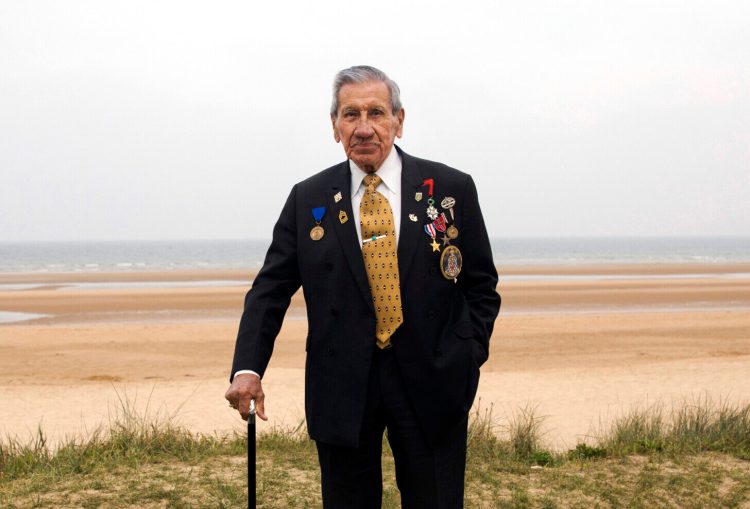June 6, 1944: Nineteen-year-old Charles Norman Shay, a Penobscot Indian, rescues drowning and wounded soldiers while under enemy fire among the first wave of attackers to land on Omaha Beach in France on D-Day. His actions earn him a Silver Star.

Shay, who grew up on Indian Island in the Penobscot River, is an Army combat medic assigned to 2nd Battalion, 16th Regiment, 1st Infantry Division, a division also known as the Big Red One. After D-Day, he takes part in the battles of Aachen, Huertgen Forest, the Ardennes (Battle of the Bulge), and the Rhine, near Remagen, Germany. The Germans capture him in the Sieg Valley, and he spends nearly a month in prisoner-of-war camps until his liberation on April 18, 1945.
Shay joins a military police company in Vienna, Austria, in 1946 and meets his Austrian wife during his four-year assignment there. In November 1950, he lands in North Korea with the 7th Regiment, 3rd Infantry Division, and takes part in combat against the invading Chinese army. Shay is promoted to master sergeant and picks up a Bronze Star.
After a stint in the Air Force that takes him to atomic bomb tests in the Pacific and hospital work in Germany, Shay moves with his wife to Vienna, where he works for the International Atomic Energy Agency and, later, the United Nations High Commission for Refugees.
In 1988, while vacationing in the Penobscots’ Indian Island village, he inherits a house there. He and his wife spend the next 15 years gradually improving it, then move there in 2003 from Austria. Shay dedicates himself to promoting and preserving Penobscot cultural heritage. He publishes booklets by or about Penobscots, operates a small museum and facilitates the republication of a book by his grandfather, “Life and Traditions of the Red Man.”
June 6, 1944: Charles Shay wasn’t the only versatile Mainer on Omaha Beach during the D-Day invasion. Another was Portland native John Martin “Bull” Feeny, better known as Hollywood movie director John Ford (1895-1973).

John Ford reached the rank of Rear Admiral in the U.S. Naval Reserve, April 1952. Photo courtesy of the U.S. Navy
Working as the photographic branch chief of the Office of Strategic Services, a U.S. intelligence agency, Ford arrived April 19 in London and began gathering camera crews and equipment to make a filmed record of the invasion.
He coordinated a plan for photographic coverage in separate meetings with the Navy, the Coast Guard, the Army, and Canadian and British forces, including the use of blackboard diagrams. He arranged to have a crew, supervised by Naval Reserve Lt. Mark Armistead, install 152 movie cameras on mounts aboard the landing craft, set to begin filming automatically when the third man or third vehicle left the boat; 500 movie cameras attached to the front of landing craft; and fixed cameras mounted to tanks.
In mid-morning on the day of the landing, Ford is aboard the destroyer USS Plunket. He clambers into an amphibious truck and heads to Omaha Beach with others as the Germans continue to fire at advancing Americans. He reminds his cameramen, who are unarmed, to lie behind cover while filming, not stand up.
When the landing is complete, Ford sends his photographers back to the ship while he proceeds inland. He makes his way to a house being used as an Army Air Forces combat camera unit’s headquarters. Then, according to biographer Joseph McBride, Ford “began drinking Calvados. He drank steadily for days on end.” The combat photo chief eventually gets somebody to take him away.
Prone to such lapses though he was, Ford’s efforts result in some of the best photography to emerge from the war.
The saloon keeper’s son and Portland High School graduate got his start in movies early. He went to the University of Maine for a while, but soon made a beeline for Hollywood, following his older brother Francis, an actor.
Ford worked as an extra in several films, including “Birth of a Nation,” but he began directing in the silent movie days.
He became one of the most influential movie directors in history, eventually winning six Academy Awards for his films, including four as best director for “The Informer,” “The Grapes of Wrath,” “How Green Was My Valley” and “The Quiet Man”; and two for his World War II documentary work. He also is known for directing John Wayne and other marquee names of the era in groundbreaking westerns.
When asked what brought him to Hollywood, he often responded, “The train.”
Presented by:

Joseph Owen is an author, retired newspaper editor and board member of the Kennebec Historical Society. Owen’s book, “This Day in Maine,” can be ordered at islandportpress.com. Joe can be contacted at: jowen@mainetoday.com.
Copy the Story Link
Comments are not available on this story.
Send questions/comments to the editors.


